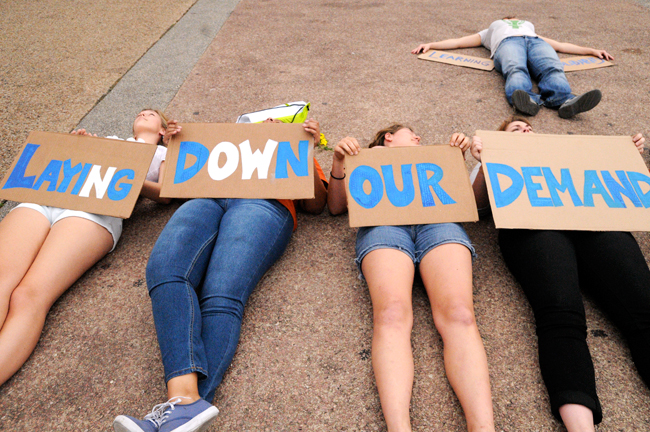Students chanted, “When workers are under attack, what do we do? Stand up, fight back,” as they walked up the steps of the Main Building in an attempt to gain an audience with President William Powers, Jr. to protest UT’s apparel manufacturers.
Students with the Make UT Sweatshop-Free Coalition organized a lay-in protest on the Main Mall in order to raise student awareness of working conditions in factories that produce University apparel. After laying on the ground, they attempted to march to the President’s office to hand him a letter with their demands, but were met by Kathy Bartsch, executive assistant to the President, who said Powers was not available to receive them, but that she would relay their message.
The Make UT Sweatshop-Free Coalition is working in conjunction with United Students Against Sweatshops to ensure better working conditions in the factories that produce University apparel. The organization’s main demand of the University is that they switch from working with the Fair Labor Association, who currently inspects the factories that produce the apparel, to the Workers Rights Consortium, who they believe will produce unbiased reports of the conditions in the factories.
Bianca Hinz-Foley, plan II junior and United Students Against Sweatshops affiliate member at UT, said Coalition members have tried to voice their concerns to the administration in the past, but the responses have been less than accommodating.
“We have been left waiting to receive responses,” Hinz-Foley said. “We contacted donors and alumni to tell them it is not acceptable to ignore students and alumni called in with their concerns.”
Hinz-Foley said student responses to the protest have been relatively positive because students feel powerful when it comes to making a change.
“The group has grown tremendously since some of the protests,” Hinz-Foley said. “I think students like to be part of something that sees tangible victories like this.”
Geoscience senior Nathan Van Oort said they planned the lay-in in order to raise the administration’s awareness of their group’s demands this semester.
“We want to set a precedent for the administration for what to expect this semester,” Van Oort said. “We want them to know that they can’t ignore us.”
Van Oort said he wants students to learn they have a unique leverage to make a difference at the University.
“Students have the power to influence the administration with their demands,” he said. “I want them to take away a sense of passion and education on the matter and I believe doing actions will influence more than words.”
Sociology senior Melissa Tran, who happened to be walking by at the time of the protest, said she thought the protest was good because it brought awareness to something that students take for granted everyday.
“I think the protest will affect what you think about when you buy the clothes,” Tran said. “I think it will also change the mind-set of students.”





















